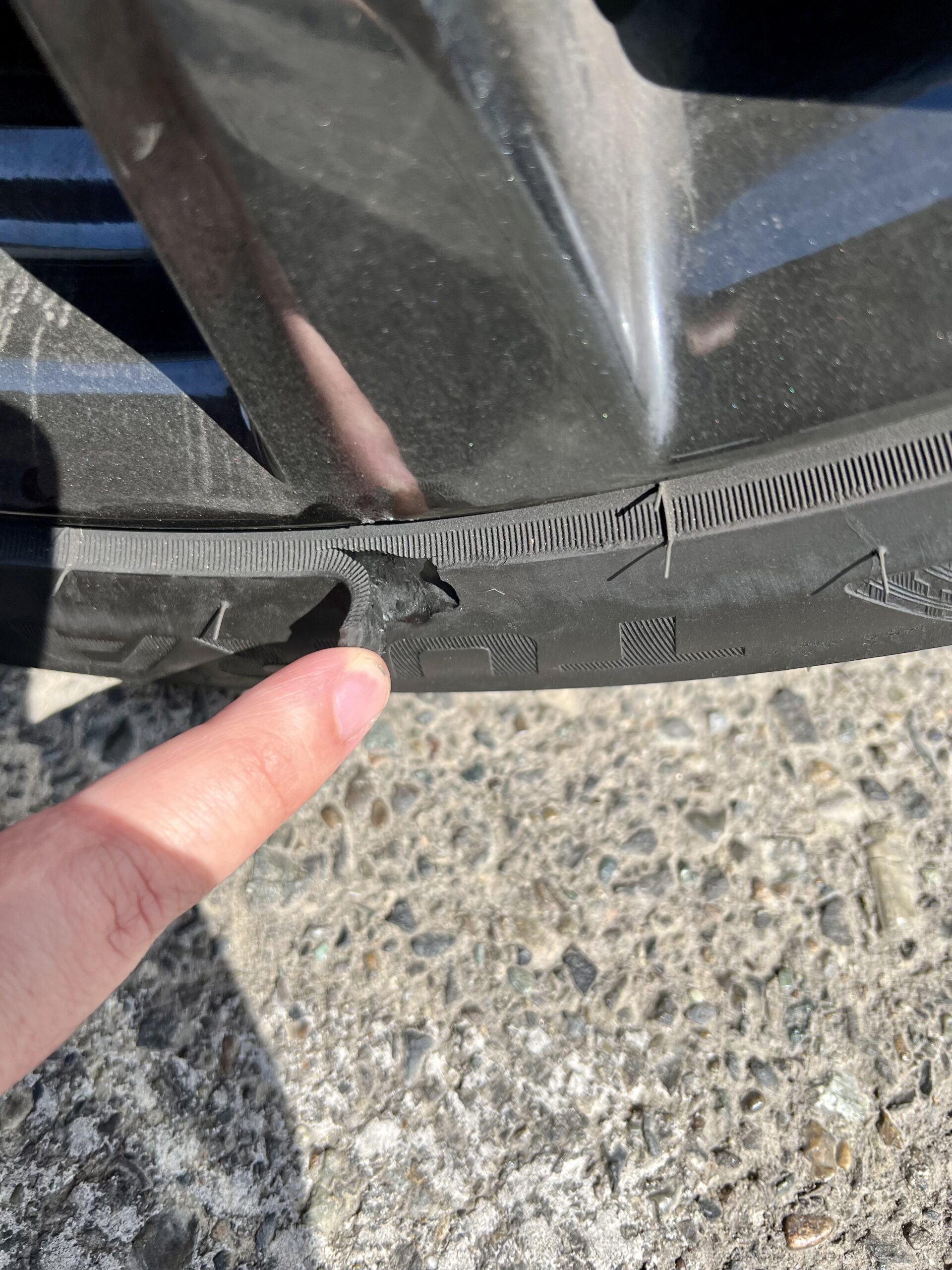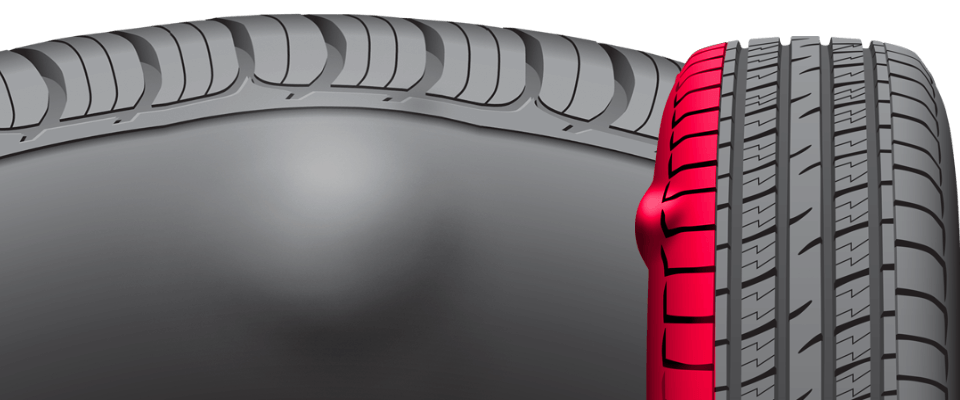Dent in tire sidewall can compromise tire integrity, leading to potential safety risks on the road. When a tire sidewall is dented, it can weaken the structure and cause bulges, cracks, or even a blowout.
Therefore, it is crucial to address the issue promptly and replace the tire if necessary. A dent in the sidewall of a tire can occur due to various reasons such as hitting a curb, pothole, or object on the road.
While it may seem like a minor issue, it can have serious consequences. The dent can weaken the tire’s structure, leading to bulges or cracks that can result in a sudden blowout while driving. Therefore, it is essential to check your tires regularly and inspect them for any sidewall dents or damage. If you notice a dent, it is recommended to have a professional evaluate the tire and replace it if needed for your safety on the road.

- Common Causes Of Dent In Tire Sidewall
- Potential Risks Of A Dent In Tire Sidewall
- Preventive Measures For Avoiding Dents
- Inspecting Your Tires For Damage
- Repair Options For Dented Tire Sidewalls
- When To Replace A Tire Instead Of Repairing
- Dealing With Emergency Situations
- Final Thoughts And Recommendations
- Frequently Asked Questions For Dent In Tire Sidewall
- Conclusion
Common Causes Of Dent In Tire Sidewall
Dents in the tire sidewall are a common occurrence that can lead to serious safety issues if left unaddressed. Understanding the causes of these dents is crucial in order to prevent them and ensure the longevity of your tires. In this section, we will explore the common causes of dents in the tire sidewall, including impact from road debris and curbside contact.
Impact From Road Debris
One of the primary reasons for dents in the tire sidewall is an impact from road debris. As you drive, there are numerous objects like rocks, nails, and other debris that can be present on the road. When your tire comes into contact with these objects, it can cause a dent in the sidewall. These dents can vary in size and severity, and if left unattended, they can lead to tire failure or even a blowout.
It’s important to be vigilant while driving and avoid running over any large debris present on the road. Additionally, maintaining a safe following distance from other vehicles can mitigate the risk of these impacts. Regularly inspecting your tires for any signs of dents or damage and promptly addressing them is crucial for ensuring your safety on the road.
Curbside Contact
Another common cause of dents in the tire sidewall is curbside contact. When parking or maneuvering, it’s not uncommon to accidentally scrape or hit the curb with your tire. These instances, although seemingly minor, can result in dents or cuts in the sidewall. Even a small dent can weaken the tire’s structure and compromise its integrity.
To avoid curbside contact, it’s essential to practice cautious parking and have an awareness of your vehicle’s proximity to the curb. Using caution and employing proper parking techniques will help minimize the risk of sidewall dents. Regularly checking your tires after such encounters and addressing any dents or damage will help maintain the longevity of your tires and ensure their optimal performance.

Credit: www.reddit.com
Potential Risks Of A Dent In Tire Sidewall
A dent in the tire sidewall can pose potential risks that should not be ignored. While it may seem like a minor issue, the consequences can be significant. In this blog post, we will explore the potential risks of a dent in the tire sidewall, including tire puncture and air leakage. Understanding these risks will help you make informed decisions and take appropriate action to ensure your safety on the road.
Tire Puncture
A dent in the tire sidewall increases the likelihood of tire puncture. When a tire’s sidewall is weakened or compromised, it becomes more susceptible to sharp objects on the road, such as nails or glass shards. Even a small dent can create a vulnerability that may lead to an eventual puncture.
It’s important to note that a punctured tire can cause inconvenience, as you would need to replace the damaged tire or repair it. Additionally, it can also lead to unexpected expenses. Punctured tires can impact your vehicle’s performance and compromise your safety while driving. Taking prompt action to address the dent can help prevent tire puncture and its associated consequences.
Air Leakage
A dent in the tire sidewall can result in air leakage. The dent weakens the seal between the tire and the rim, creating an opening that allows air to escape. Gradual air leakage can lead to low tire pressure, affecting your vehicle’s handling and fuel efficiency. It is crucial to maintain the proper tire pressure to ensure optimal performance and safety.
Low tire pressure can also cause increased tire wear and heat buildup, potentially leading to tire blowouts. A blowout can be a dangerous situation, especially at high speeds. By addressing the dent in the tire sidewall, you can reduce the risk of air leakage and prevent the complications associated with low tire pressure.
Proper tire maintenance, including regular inspections and taking swift action when a dent is discovered, is key to preventing tire puncture, air leakage, and other potential risks.
Preventive Measures For Avoiding Dents
When it comes to Preventive Measures for Avoiding Dents in tire sidewalls, taking proactive steps can help prolong the life of your tires and ensure your safety on the road.
Maintaining Proper Tire Pressure
Maintaining proper tire pressure is crucial to prevent dents in the sidewall. Use a tire pressure gauge regularly to check and adjust the pressure according to the manufacturer’s recommendations.
Avoiding Rough Roads
Avoiding rough roads can significantly reduce the risk of dents in your tire sidewalls. Whenever possible, choose smooth, well-maintained roads to preserve the integrity of your tires.

Credit: www.discounttire.com
Inspecting Your Tires For Damage
Regularly inspecting your tires for damage is crucial for ensuring your safety on the road. One of the most important aspects of tire maintenance is checking for any dents in the tire sidewall. Not only can these dents compromise the structural integrity of the tire, but they can also lead to potential blowouts and accidents. In this section, we’ll discuss the essential steps to inspect your tires for damage, specifically focusing on the sidewall.
Visual Checks
The first step in inspecting your tires for damage is to visually examine the sidewalls. Look for any visible dents, bulges, or cuts on the sidewall surface. These irregularities can be indicative of internal tire damage and should be addressed promptly.
Running Your Hands Along The Sidewall
In addition to the visual inspection, running your hands along the sidewall can help detect any subtle abnormalities that may not be immediately visible. Feel for any indentations or areas of unusual softness, as these could be signs of damage beneath the surface of the tire.
Repair Options For Dented Tire Sidewalls
Discover repair solutions for dented tire sidewalls to restore optimal performance and safety. Professional assessment is crucial for determining the best course of action. Seek assistance from certified technicians to address the dent effectively.
Repair Options for Dented Tire Sidewalls When your tire sidewall incurs a dent, it’s essential to address the issue promptly to ensure your safety on the road. Fortunately, there are various repair options available for dented tire sidewalls. Let’s explore two common solutions: Patch and Sealant Kits and Professional Repair Services. Patch and Sealant Kits These cost-effective kits offer a convenient, DIY solution for minor dents on your tire sidewall. They typically come with a patch, sealant, and instructions for quick and easy application. The process involves cleaning the damaged area, applying the patch, and sealing it with the provided sealant. While these kits may provide a temporary fix, it’s important to note that they are not suitable for severe damage or large dents. Professional Repair Services Seeking the expertise of professional repair services can ensure a thorough and long-lasting solution for dented tire sidewalls. These professionals have the necessary tools and knowledge to assess the extent of the damage and provide a suitable repair. Generally, they will evaluate the dent and determine whether it can be safely repaired. If the damage is beyond repair, they may recommend a tire replacement to ensure your safety on the road. In both cases, it’s crucial to address dents on tire sidewalls promptly to prevent further damage and maintain road safety. Whether opting for a patch and sealant kit or professional repair services, prioritizing the condition of your tire sidewalls can help ensure a smooth and safe driving experience.When To Replace A Tire Instead Of Repairing
If you notice a dent in the tire sidewall, it’s best to replace the tire instead of repairing it. A damaged sidewall compromises the structural integrity, making it unsafe to drive. It’s crucial to ensure your safety on the road by promptly replacing a tire with a dent in the sidewall.
Depth Of The Dent
Inspect the dent’s depth by visually examining if it’s beyond 1/4 inch.
Damage Extent
Assess the overall tire damage – bulges, cuts, or punctures.
Not all tire dents can be patched. Assess the depth and overall damage to determine if replacement is necessary.
Dealing With Emergency Situations
When faced with a dent in your tire sidewall, it’s essential to stay calm and assess the situation. Immediately check for any signs of air leakage and avoid driving on the damaged tire. Contact a professional for assistance and consider replacing the tire to ensure safety on the road.
When it comes to driving, unexpected situations can arise, leaving us in a state of panic and uncertainty. One such situation is a dent in the tire sidewall. Not only can this be alarming, but it can also compromise the safety of your vehicle. Knowing how to handle this emergency is crucial, so let’s explore some temporary solutions and how to contact roadside assistance.
Temporary Solutions
If you find yourself with a dent in your tire sidewall, don’t worry. There are a few temporary solutions you can try before reaching out for professional help. Keep in mind that these fixes are short-term and should not be seen as permanent solutions.
- Inspect the damage: First, assess the severity of the dent in your tire sidewall. If it’s a minor dent and there are no signs of significant damage, you may be able to proceed with these temporary fixes.
- Cover the dent with a tire sealant: Tire sealants are readily available and can temporarily seal small punctures or leaks in the tire. Follow the instructions on the product carefully for the best results. Remember, this is only a temporary solution to get you to the nearest repair facility.
- Use a temporary tire plug: Another option is to use a temporary tire plug kit. These kits usually contain a plug and adhesive, which can be inserted into the punctured area. Again, this is not a permanent fix, but it can provide some relief until proper repairs can be made.
- Reduce your speed and distance: While driving with a dent in your tire sidewall can be risky, reducing your speed and limiting your distance can help minimize further damage. Drive cautiously and avoid rough roads or potholes that could worsen the dent.
Contacting Roadside Assistance
If the dent in your tire sidewall seems severe, or if you’re unsure about attempting temporary solutions, it’s best to contact roadside assistance. They are trained professionals who can assess the situation and provide appropriate assistance.
When contacting roadside assistance, remember the following:
- Have essential information ready: Before making the call, gather important details such as your location, vehicle make and model, and any relevant insurance information that may be required.
- Explain the situation clearly: Clearly describe the dent in your tire sidewall and any symptoms you may have noticed. This information will help the roadside assistance provider assess the urgency of your situation.
- Follow their instructions: Listen carefully to the instructions provided by the roadside assistance representative. They may guide you on what steps to take while waiting for help to arrive.
Remember, in emergency situations like these, staying calm is essential. By following these temporary solutions and contacting roadside assistance promptly, you can address the dent in your tire sidewall and ensure your safety on the road.
Final Thoughts And Recommendations
Regular tire maintenance and safe driving practices are crucial in preventing and addressing dent in tire sidewall issues. By following these suggestions, you can extend the lifespan of your tires, ensure your safety, and save money on expensive repairs or replacements.
Regular Tire Maintenance
Maintaining your tires properly can help you avoid a dent in the sidewall. Here are some essential tips for regular tire maintenance:
- Check tire pressure: Regularly inspect your tire pressure to ensure they are properly inflated. Underinflated tires may lead to bulges or dents in the sidewall.
- Inspect tread depth: Monitor the tread depth of your tires and replace them if they are worn out. Worn-out tires are more susceptible to sidewall damage.
- Rotate your tires: Regularly rotate your tires to promote even wear. This can help prevent uneven pressure on the sidewalls, reducing the risk of dents.
- Keep an eye on tire wear and tear: Regularly check your tires for signs of wear and tear, such as cracks or bulges. Address these issues promptly to prevent further damage.
Safe Driving Practices
In addition to regular maintenance, practicing safe driving habits can also help prevent dent in tire sidewall incidents. Follow these recommendations:
- Watch out for potholes and debris: Be vigilant and avoid driving over potholes, rocks, or other debris that can cause damage to your tires.
- Steer clear of curbs: Avoid running into curbs or other obstructions that can scrape or dent your tire sidewalls.
- Slow down on rough roads: Reduce your speed when driving on rough or uneven roads to minimize the impact on your tires.
- Avoid excessive overloading: Do not overload your vehicle beyond its recommended weight capacity. Excessive weight can put excessive strain on your tires, leading to sidewall damage over time.
By following these regular maintenance tips and safe driving practices, you can significantly reduce the risk of experiencing a dent in your tire sidewall. Take care of your tires, and they will take care of you.

Credit: www.discounttire.com
Frequently Asked Questions For Dent In Tire Sidewall
What Causes A Dent In A Tire Sidewall?
A dent in a tire sidewall is usually caused by hitting a curb, pothole, or debris on the road. It can also be the result of a manufacturing defect or worn-out tire.
Can A Dent In The Tire Sidewall Be Repaired?
No, a dent in the tire sidewall cannot be repaired. It compromises the structural integrity of the tire and poses a safety risk. It’s essential to replace the damaged tire to ensure safe driving.
How To Prevent Dents In Tire Sidewalls?
You can prevent dents in tire sidewalls by avoiding rough road conditions, regularly checking tire pressure, and maintaining proper wheel alignment. It’s also important to choose high-quality tires with strong sidewalls.
Conclusion
Addressing a dent in the tire sidewall is crucial for safety. Regular inspections can prevent accidents. Seeking professional help is advisable for proper repairs. Don’t ignore sidewall damage as it can lead to bigger issues. Stay proactive for a smoother driving experience.